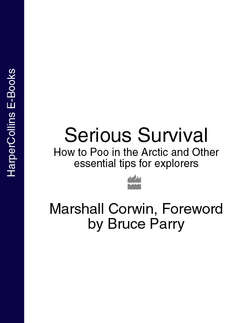Читать книгу Serious Survival: How to Poo in the Arctic and Other essential tips for explorers - Bruce Parry - Страница 17
ОглавлениеThe Arctic Ocean is one of the wonders of the world, made up of vast, ever-changing masses of ice floating on the sea beneath. As ice sheets shift in the wind and current they collide to form pressure ridges, spectacular areas of ice which may be several metres high – and often extremely difficult for adventurers to cross.
As the ice drifts or breaks up it leaves dangerous cracks or open areas of sea. The ice can vary greatly in thickness, ranging from about 0.5–4m (roughly 2–14ft).
Around half the Arctic Ocean stays frozen all year, with parts nearer the edge of the Arctic Circle melting in spring and refreezing in the autumn.
PACK ICE OR ICE FLOE?
Huge, fairly continuous sheets of sea ice are known as pack ice, while smaller free-floating chunks less than around 8km (5 miles) wide are called ice floes. Huge icebergs that have broken away from glaciers can also be found floating in the Arctic Ocean.
The Serious Arctic training camp on the sea ice in the middle of Frobisher Bay in April.
HOW DO YOU travel about on the frozen ocean?
You might wonder why anyone ventures onto the frozen ocean in the first place. There are in fact a variety of reasons:
In mountainous regions with difficult terrain the frozen ocean is like a ‘motorway’, providing faster, direct routes to other areas
For adventurers it’s often the only way to reach their goal, including of course the North Pole itself
Local people need to head onto the sea ice to fish and hunt for animals like seals and polar bears
The traditional way of travelling across the frozen ocean is by dogsled replaced in recent times in many areas by the snowmobile.
If travelling under your own steam the best way to take your kit is by pulling a small sledge called a pulk behind you. It’s the stuff of real polar exploration and is actually not as hard as it looks – until you hit the nightmare of pressure ridges. Stopping when going downhill back on the frozen land is also quite an art.
WHY DOESN’T the frozen sea crack up when the tide comes in?
To an extent it does. Each day the sea ice may rise or fall by several metres with the tides. At the shoreline the frozen sea is stuck fast to the land (it’s actually known as fast ice for that reason), so something’s got to give. Usually it means long cracks appear in the ice, perhaps about 100m (300ft) from the shore, where the ice ‘hinges’ up or down and eventually breaks. The open water will usually refreeze quickly, but it can be a treacherous area to travel over.
HOW CAN YOU check if the ice is strong enough to walk on?
The short answer is that unless you’re an expert you can’t. Sea ice and frozen lakes are incredibly dangerous, and while there are safety pointers like the colour of the ice (clear blue or green ice is usually stronger), this is definitely one to leave to an experienced local guide. They will know the hazards. For example, snow may be hiding a weak area of sea ice regularly cracked by the tides.
As a general rule, a layer of ice less than 10cm (4in) thick is too thin to walk on, but even ice much thicker may have unseen weak spots and could quickly change depending on the conditions. Getting across successfully is absolutely no guarantee the ice will still be safe an hour or two later.
WHAT HAPPENS IF the ice cracks and you fall in?
This is guaranteed to be one of the less pleasant experiences in life – and could all too easily end it. The water under the ice is around freezing point (if it’s the sea rather than a freshwater lake, it may actually be a degree or two below zero as saltwater has a lower freezing point).
Your body’s reflex reaction to hitting the ice cold water is involuntary gasping. If at all possible, keep your head above water and/or cover your mouth to avoid taking in water and drowning. You will feel winded and hyperventilate, fighting to catch your breath. The natural instinct is to panic, desperately trying to get out as quickly as possible. This is understandable but usually serves only to increase the chances of drowning.
Just concentrate on staying afloat and getting your breath back. It may take a couple of minutes, but you should have a good five minutes before you become too cold and weak to help yourself. Then look around for a firm enough bit of ice to get your arms and chest out of the water – often where you fell in is best. It can be very difficult to heave yourself out onto the slippery ice, so once you’ve got your arms out get into a horizontal swimming position, kicking your legs to help crawl forward onto the ice.
Don’t try to stand up as the ice may be very weak. Keep lying down so your weight is spread out, and roll well away from the edge.
Even if you can’t get out, don’t panic. You can survive for at least fifteen minutes, possibly over an hour, and hopefully there will be someone nearby to help rescue you.
Your rescuers will, of course, have to be very careful not to fall in themselves. If possible they should stay well away from the edge, passing you a long branch or a rope with a big loop to put under your arms (you will be pretty numb by now).
If all has gone well you will have only mild hypothermia, but will still need to be warmed up.
